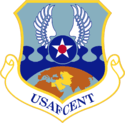737th Expeditionary Airlift Squadron
737th Expeditionary Airlift Squadron
 | |
|---|---|
|
Squadron airmen loading a C-130 Hercules in Southwest Asia | |
| Active | 1943-1945; 1947-1949; 1952-1953; 2000s |
| Country |
|
| Branch |
|
| Role | Airlift |
| Decorations |
Distinguished Unit Citation Air Force Meritorious Unit Award |
| Insignia | |
| 737 Expeditionary Airlift Squadron emblem |
 |
| Squadron morale patch[note 1] |
 |
The 737th Expeditionary Airlift Squadron is a provisional United States Air Force unit. It is under the control of Air Mobility Command and operates C-130 Hercules aircraft in theater airlift missions as part of the Global War on Terrorism. Its current status and duty location is undetermined.
In regular USAF service as the 737th Troop Carrier Squadron (Medium), it was last assigned to the 454th Troop Carrier Wing, being stationed at Portland International Airport, Oregon. It was inactivated on 1 January 1953.
History
World War II
The squadron was first activated at Alamogordo Army Air Field, New Mexico in mid-1943 as the 737th Bombardment Squadron, one of the four Consolidated B-24 Liberator heavy bombardment squadrons assigned to the 454th Bombardment Group.[1] The unit trained under Second Air Force. After training in the United States, the squadron deployed to the Mediterranean Theater of Operations in late 1943 and was stationed at San Giovanni Airfield under Fifteenth Air Force.[2]
The unit engaged in very long range strategic bombardment of enemy military, industrial and transportation targets. It initially flew some interdiction and ground support missions, participating in the drive to Rome. Most operations included attacks against such objectives as marshalling yards, aircraft factories, railroad bridges, and airdromes in Italy, Austria, and Romania. The squadron was awarded a Distinguished Unit Citation for an attack on an airfield at Bad Voslau, Austria on 12 April 1944. It helped to prepare the way for and supported Operation Dragoon, the invasion of southern France, during July and August 1944. At the same time, expanded previous operations to include attacks on oil refineries and storage facilities, locomotive works, and viaducts in France, Germany, Czechoslovakia, Hungary, Austria, and in the Balkans. It earned a second Distinguished Unit Citation on 25 July when the 454th Group led the 304th Bombardment Wing through severe opposition in an attack on steel factories at Linz, Austria.[1]
The squadron returned to the United States after VE Day in May 1945. It began to reorganize as a Boeing B-29 Superfortress very heavy bombardment squadron. Began training under Second Air Force in August 1945, however was inactivated in October after VJ Day.[2]
Air Force reserve
The squadron was activated as a reserve unit under Air Defense Command (ADC) at McChord Field, Washington in August 1947 as a very heavy bombardment squadron, where its training was supervised by the 406th AAF Base Unit (later the 2345th Air Force Reserve Training Center). It does not appear to have been equipped or fully manned.[3] The 737th was inactivated when Continental Air Command reorganized its reserve units under the wing base organization system in June 1949.[2] The squadron's personnel and equipment were transferred to elements of the 302d Troop Carrier Wing, which was simultaneously activated at McChord.[4] This reorganization was also impacted by President Truman’s reduced 1949 defense budget also required reductions in the number of unit in the Air Force,[5]
The 737th was reactivated at Portland International Airport in June 1952 as the 737th Troop Carrier Squadron when the 454th Troop Carrier Wing replaced the 922d Reserve Training Wing at Portland. it was inactivated on 1 January 1953 with its personnel and equipment being reassigned to the 64th Troop Carrier Squadron[6] when the 403d Troop Carrier Wing was released from active duty and replaced the 454th Wing as Portland's air reserve unit.[7]
Expeditionary airlift
The squadron was converted to provisional status and redesignated 737th Expeditionary Airlift Squadron. It was activated as a Lockheed C-130 Hercules airlift squadron as part of the Global War on Terrorism.
Lineage
- Constituted as the 737th Bombardment Squadron (Heavy) on 14 May 1943
- Activated on 1 June 1943
- Redesignated 737th Bombardment Squadron, Heavy c. 1944
- Redesignated 737th Bombardment Squadron, Very Heavy on 5 August 1945
- Inactivated on 17 October 1945
- Activated in the reserve on 16 August 1947
- Inactivated on 27 June 1949
- Redesignated 737th Troop Carrier Squadron, Medium on 26 May 1952
- Activated in the reserve on 13 June 1952
- Inactivated on 1 January 1953[2]
- Redesignated: 737th Expeditionary Airlift Squadron and converted to provisional status after 11 September 2001
Assignments
- 454th Bombardment Group, 1 June 1943 - 17 October 1945
- 454th Bombardment Group, 16 August 1947 - 27 June 1949
- 454th Troop Carrier Group, 13 June 1952 - 1 January 1953[2]
- Air Mobility Command to activate or inactivate as required.
- 386th Expeditionary Operations Group
Stations
- Alamogordo Army Air Field, New Mexico, 1 June 1943
- Davis-Monthan Field, Arizona, 1 July 1943
- McCook Army Air Field, Nebraska, c. 31 July 1943
- Charleston Army Air Field, South Carolina, 3 October – December 1943
- San Giovanni Airfield, Italy January 1944 – July 1945
- Sioux Falls Army Air Field, South Dakota, 1 August 1945
- Pyote Army Air Field, Texas, 17 August – 17 October 1945
- McChord Field (later McChord Air Force Base), Washington, 27 April 1947 – 27 June 1949
- Portland International Airport, Oregon, 13 June 1952 – 1 January 1953[2]
- Ali Al Salem Air Base, Kuwait, unknown
Aircraft
- Consolidated B-24 Liberator, 1943-1945
- Boeing B-29 Superfortress, 1945
- Lockheed C-130 Hercules 2000s[2]
References
- Notes
- ↑ This patch is based on the World War II emblem of the 454th Bombardment Group. Watkins, pp. 98-99
- Citations
- 1 2 Maurer, Combat Units, p. 329
- 1 2 3 4 5 6 7 Maurer, Combat Squadrons, pp. 728-729
- ↑ See Maurer, Combat Squadrons, pp. 728-729 (no aircraft listed for this period)
- ↑ Ravenstein, pp. 147-149
- ↑ Knaack, p. 25
- ↑ See Maurer, Combat Squadrons, p. 245 (activation of squadron at Portland on 1 January 1953)
- ↑ Ravenstein, 215-217
Bibliography
![]() This article incorporates public domain material from the Air Force Historical Research Agency website http://www.afhra.af.mil/.
This article incorporates public domain material from the Air Force Historical Research Agency website http://www.afhra.af.mil/.
- Cantwell, Gerald T. (1997). Citizen Airmen: a History of the Air Force Reserve, 1946-1994 (PDF). Washington, D.C.: Air Force History and Museums Program. ISBN 0-16049-269-6. Retrieved October 1, 2014.
- Knaack, Marcelle Size (1978). Encyclopedia of US Air Force Aircraft and Missile Systems. Vol. 2, Post-World War II Bombers 1945-1973. Washington, DC: Office of Air Force History. ISBN 0-912799-59-5.
- Maurer, Maurer, ed. (1983) [1961]. Air Force Combat Units of World War II (PDF) (reprint ed.). Washington, DC: Office of Air Force History. ISBN 0-912799-02-1. LCCN 61060979.
- Maurer, Maurer, ed. (1982) [1969]. Combat Squadrons of the Air Force, World War II (PDF) (reprint ed.). Washington, DC: Office of Air Force History. ISBN 0-405-12194-6. LCCN 70605402. OCLC 72556.
- Ravenstein, Charles A. (1984). Air Force Combat Wings, Lineage & Honors Histories 1947-1977 (PDF). Washington, DC: Office of Air Force History. ISBN 0-912799-12-9.
- Watkins, Robert A. (2009). Insignia and Aircraft Markings of the U.S. Army Air Force In World War II. Volume IV, European-African-Middle Eastern Theater of Operations. Atglen,PA: Shiffer Publishing, Ltd. ISBN 978-0-7643-3401-6.
